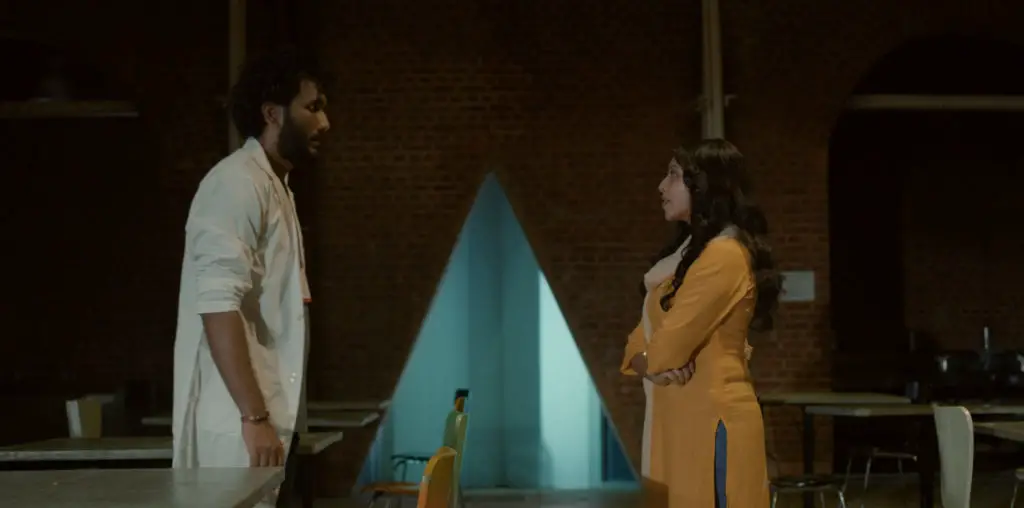
The most dispiriting experiences you can have watching a film are directly tied to spoiled potential. Ramaa Mosley has already established herself as a significant new talent with her directorial debut The Brass Teapot in 2012, as well as her serving as producer on Richard Robbins’ Girl Rising in 2013. Now she returns to navigate the landscape of local folklore and the effects of both childhood and military trauma, setting it against the backdrop of the American Ozark Mountains. While Lost Child plays about with some lofty themes within a unique microculture, it’s disappointingly toothless as a dramatic thriller.
Fern (Leven Rambin) is a young veteran, who suffers from Post Traumatic Stress Disorder. She is returning from a recent tour on a mission to seek out her estranged brother Billy (Taylor John Smith), currently adrift out in the mountains. While using her deceased father’s cabin as a base, she searches the surrounding areas and questions the locals, reconnecting with Florine (Toni Chritton Johnson), a childhood acquaintance, and begrudgingly befriending Mike (Jim Parrack), a well-meaning bartending social worker. One day she comes across a young boy Cecil (Landon Edwards) skulking about in the forest. Upon taking him into her home, a weird sickness starts to overtake Fern, calling into question to what Cecil is precisely, and if he is as benign as he appears.

“…returning from a recent tour…to seek out her estranged brother…currently adrift out in the mountains.”
From the credits onward, the forest is as much a character of this film as the desert was in Lawrence of Arabia. However, but unlike David Lean’s film, this one seems to have missed the trees for the forest (even literally). Its excess of nature photography stifles much of the film’s rhythm and focus, resulting in an oddly soft-handed approach to its themes.
While the main character is meant to have PTSD due to her multiple army tours, the film rarely references it outside of a handful of plot conveniences. It hardly sells as a legitimate character trait (as it comes and goes on the whim of Mosley and co-writer Tim Macy) when it could have been the most fascinating aspect to explore about Fern. This is especially true since her brother Billy successfully contains some of the most volatile effects of post-trauma (though for different reasons). Though Rambin manages a believable performance in the given context, the character herself is somewhat incomplete.

“…brother Billy contains some of the most volatile effects of post-trauma…”
Also, though there are moments in his performance where Edwards manages an interesting dynamic with Rambin, then its undone by the muted atmosphere. There just isn’t any tension (building or otherwise) to support the film, and his presence is more like an awkward casting decision rather than a mysterious character. This also can be said for a few of the supporting cast as well, which makes me believe that the filmmakers knew exactly what kind of characters they wanted (judging by their fair, albeit extremely brief representation of fringed communities in the Ozarks), they just didn’t actually bring them to three-dimensional life.
But what really dams any undercurrent of suspense is the constant day-for-night cinematography that sucks all seriousness out of each scene it’s used; the moon does not shine that damn bright. Since there are scenes that were actually shot at night that easily contrast these other sequences, Mosley and cinematographer Darin Moran should have known that we would make the distinction (and also that an essential scene in the latter half of the film is constructed strikingly similar to a pinnacle moment in Mulholland Dr).
Though Lost Child does try to strike at a deeper emotional core through its mishmash of tropes, the over-glossed methodology and cheap resonance make the experience ultimately (and thoroughly) underwhelming.

Lost Child (2018) Directed by Ramaa Mosley. Written by Ramaa Mosley, Tim Macy. Starring Leven Rambin, Taylor John Smith, Toni Chritton Johnson, Jim Parrack, Landon Edwards.
3 out of 10



Just watched this tonight. I think
it’s a jewel. No bad performances, interesting and while it’s no fancy Poltergeist movie with ghosts and demons and special effects, it held my attention from start to finish, I felt a lot of tension, and had an uncomfortable feeling trying to figure out whether this kid is a demon or what. What else can you ask from a good horror or suspense movie? And to find out it was made on a shoestring budget? I never would have guessed. It was just as slick and professional as anything else Blum House has put out lately. And I’m a hard movie watcher to please. Nice job guys. Hope you make more like it!
Ignore this review. The things that were apparently a problem you won’t even notice. Great little film. Well shot and acted.
This film was made for $15k. Very harsh review in my opinion. Context of a film like this is important. Especially for female filmmakers who are now negatively impacted by your review on rotten tomatoes.
To add to Jill’s comment about the ultra-low, almost non-existent budget:
Leven Rambin, Taylor John Smith and Jim Parrack were the only professional actors in this film.
Landon Edwards was eleven at the time we filmed. He had never acted, and had no training.
Toni Chritton Johnson’s (that’ me, AKA Florine) acting experience consisted of a couple of small-town community theater projects.
Kip Collins had no training, no experience.
Given the budget constraints, I think we made a pretty darn good flick.
Well said, Jill. Thank you.